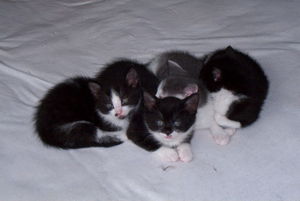Many pet enthusiasts know that calico and tortoiseshell cats are typically female. Some even brag that they’ve paid for a male, and that their cat is rare. Why does this particular color pattern happen mostly in female cats?
What is Calico, or Tortoiseshell?
Both calico and tortoiseshell refer to cats that have three colors of fur, AKA tricolors. In America, the terms are sometimes used interchangeably, and these cats are also called “money” cats. Their coloring is black, red, and cinnamon. Some of these cats also have white patches. Calico cats typically have groups of spots, which tortoiseshells are spotted all over. Another variation of these cats is “dilute,” which means that instead of blac, red, and cinnamon, they tend to be blue (like a Russian Blue), fawn (a light brown) and white. Photos can be found here.
How do they get to be this color, anyway?
To answer this, I need to get into genetics. Cats, much like humans, have 2 chromosomes, one from each parent. The female cat as two X chromosomes, while the male has X from its mother and Y from its father. Because female can get two X genes, they can get the genes for both black and orange, according to petplace.com. So, for a male cat to be calico or tortoiseshell, it would need to have a genetic defect! To have the right genes, the car would need two X chromosomes in addition to its Y. In humans, this defect is called Klinefelter’s Syndrome.
So, what about the males?
According to VeterinaryPartner.com, only about one in 3000 tricolor cats is male and has multiple X chromosomes. These cats, because of that genetic defect, are typically sterile. Even if they are not (only 1 in 10,000 are fertile!), they will not produce tricolor male kittens unless these kittens have the same deformity.








